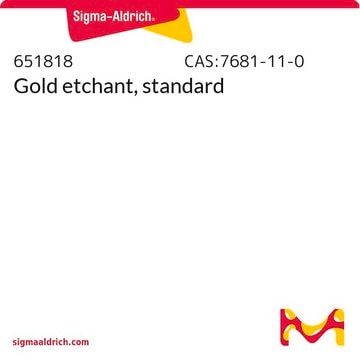643254
Gold coated glass cover slip
99.999% (Au), layer thickness 100 Å, L × W × thickness 22 mm × 22 mm × 130-170 μm, square
About This Item
Productos recomendados
assay
99.99% (Ti)
99.999% (Au)
L × W × thickness
22 mm × 22 mm × 130-170 μm, square
layer thickness
100 Å
refractive index
n20/587 1.523
matrix attachment
Titanium, as adhesion layer used to bind the gold to the borosilicate glass cover slip
SMILES string
[Au]
InChI
1S/Au
InChI key
PCHJSUWPFVWCPO-UHFFFAOYSA-N
¿Está buscando productos similares? Visita Guía de comparación de productos
Categorías relacionadas
Features and Benefits
Other Notes
Legal Information
Storage Class
13 - Non Combustible Solids
wgk_germany
nwg
flash_point_f
Not applicable
flash_point_c
Not applicable
Certificados de análisis (COA)
Busque Certificados de análisis (COA) introduciendo el número de lote del producto. Los números de lote se encuentran en la etiqueta del producto después de las palabras «Lot» o «Batch»
¿Ya tiene este producto?
Encuentre la documentación para los productos que ha comprado recientemente en la Biblioteca de documentos.
Los clientes también vieron
Nuestro equipo de científicos tiene experiencia en todas las áreas de investigación: Ciencias de la vida, Ciencia de los materiales, Síntesis química, Cromatografía, Analítica y muchas otras.
Póngase en contacto con el Servicio técnico








